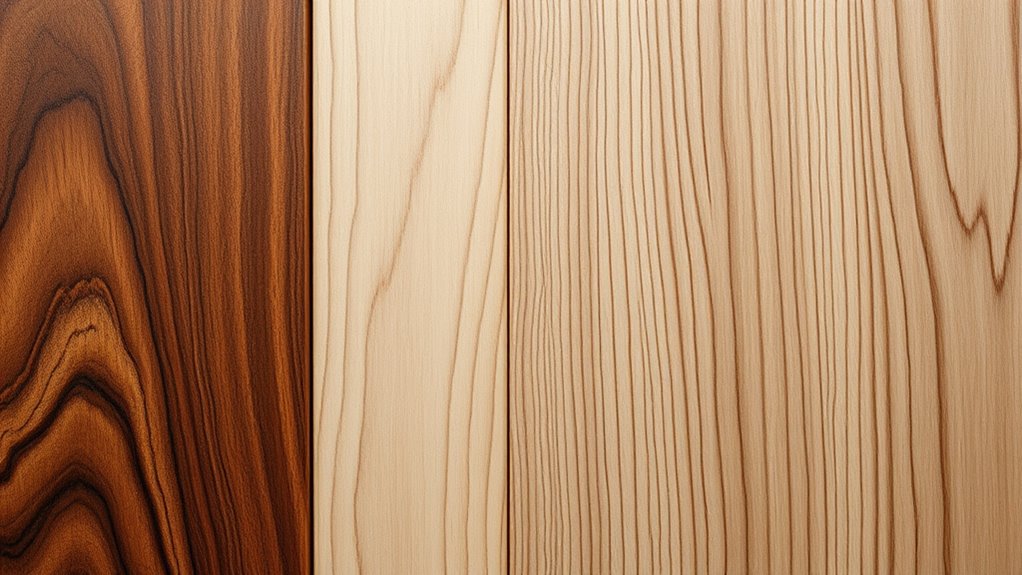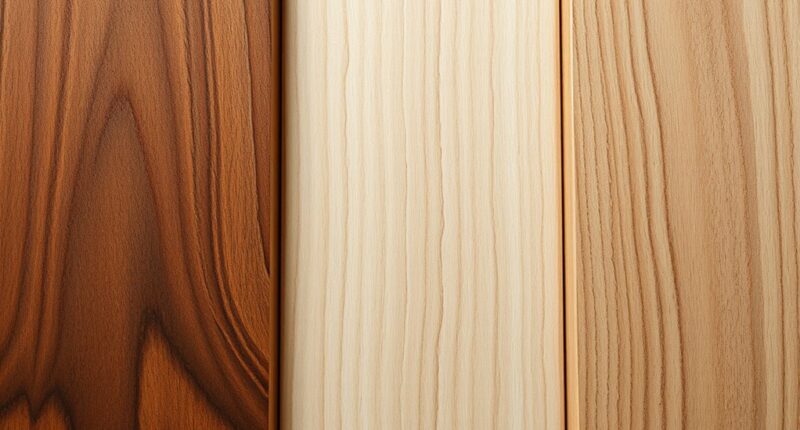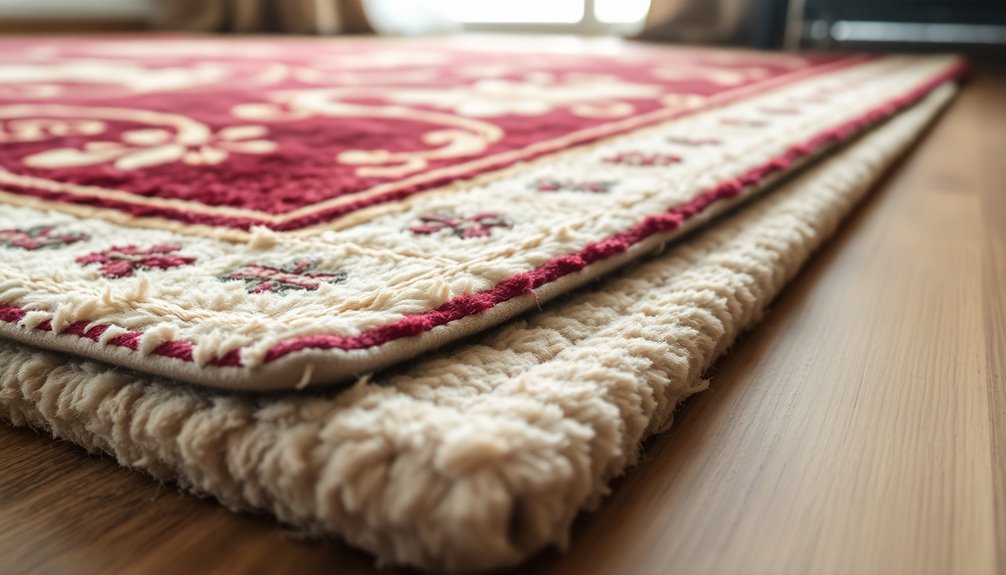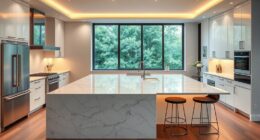When choosing cabinetry woods like walnut, white oak, or rift-sawn oak, you get unique grain patterns, tones, and durability suited to your style and environment. Walnut offers rich, deep hues with fine, luxurious grain, ideal for sophisticated spaces. White oak provides strength and warmth with a textured, rustic look, great for humid areas. Rift-sawn oak delivers minimal knots and sleek lines for modern aesthetics. Exploring these options helps you find the perfect balance of beauty and resilience—there’s more to discover ahead.
Key Takeaways
- Walnut offers rich, dark tones with fine grain, providing a luxurious and durable finish for high-end cabinetry.
- White Oak features prominent grain and strength, suitable for rustic or contemporary styles, and resists moisture and decay.
- Rift-sawn oak delivers uniform, linear grain with minimal knots, enhancing modern aesthetics and stability.
- Finishing techniques like gloss or matte enhance the wood’s natural beauty and protect cabinetry from wear.
- Choosing the right wood balances visual appeal and durability, ensuring long-lasting, stylish cabinetry.

Have you ever wondered what makes cabinetry woods both durable and visually appealing? It’s a blend of natural properties, craftsmanship, and the unique characteristics each species brings to the table. When selecting wood for cabinets, understanding these qualities helps you make a choice that balances longevity with aesthetic appeal. For example, walnut stands out for its rich, deep hues and fine grain, making it a favorite for those seeking a luxurious, timeless look. Its dense composition grants it excellent stability and resistance to dents and scratches, ensuring your cabinets maintain their elegance over time. The dark chocolate tones and subtle swirls in walnut’s grain pattern lend a sophisticated aura that can elevate any kitchen or bathroom design. Additionally, the natural durability** of certain woods influences how well they withstand everyday wear and environmental factors. White oak, on the other hand, offers a different set of advantages. Known for its strength and coarse, prominent grain, white oak provides a rustic yet refined appearance. Its open grain pattern creates a textured surface that’s both tactile and visually interesting, especially when finished with a clear coat to highlight its natural character. White oak’s inherent resistance to moisture and decay makes it ideal for high-humidity environments, adding to its durability. Its light, warm tones blend seamlessly with various design styles—from traditional to contemporary—making it incredibly versatile. When you choose white oak, you’re opting for a material that combines robustness with a welcoming, organic look. Rift-sawn oak introduces a technical refinement to the traditional oak. This sawing method involves cutting the log at a specific angle, which results in a more uniform grain pattern and less visible rays compared to plain-sawn oak. The process produces a linear, consistent grain with minimal knots or irregularities, giving your cabinets a sleek, modern aesthetic. Rift-sawn oak not only emphasizes the wood’s linear qualities but also reduces expansion and contraction due to its stable grain orientation. This stability is vital for maintaining precise panel fit and alignment over years of use. Its subtle, understated appearance pairs well with minimalist or contemporary designs, offering a clean, streamlined look that’s both functional and stylish. Beyond these specific woods, the way you finish and treat the material plays a vital role in highlighting its natural beauty and enhancing durability. Whether you prefer a smooth, glossy lacquer or a matte, hand-rubbed oil finish, your choice impacts the wood’s appearance and longevity. Properly selected and crafted cabinetry woods provide a harmonious blend of visual appeal** and resilience, ensuring your investment remains stunning and functional for years to come.
Frequently Asked Questions
How Do Different Woods Impact Cabinetry Durability?
Different woods substantially impact your cabinetry’s durability. Hardwoods like oak and walnut resist dents and scratches better, making them ideal for high-use areas. Softwoods, such as pine, are more prone to damage but are easier to carve and finish. Rift-sawn wood offers added stability, reducing warping over time. By choosing the right wood, you guarantee your cabinets withstand daily wear and tear, maintaining their beauty and strength for years.
Are Certain Woods Better for Specific Kitchen Styles?
Yes, certain woods suit specific kitchen styles better. For a modern look, you might choose sleek White Oak or Walnut with smooth finishes, emphasizing clean lines. Rustic designs benefit from Rift-Sawn White Oak or Walnut with pronounced grain patterns, adding warmth. If you prefer a minimalist aesthetic, light-colored woods like White Oak complement that vibe. You choose based on the ambiance you want, knowing each wood’s texture and tone enhances your kitchen’s style.
How Does Wood Grain Affect Cabinet Maintenance?
You’ll notice that wood grain profoundly influences cabinet maintenance; a prominent, open grain like white oak, for instance, shows scratches and dirt more readily, requiring frequent cleaning and careful handling. Conversely, tight, smooth grains like walnut hide fingerprints and minor blemishes, making upkeep easier. Understanding how grain patterns interact with light and wear helps you choose woods that align with your lifestyle, ensuring your cabinets stay beautiful longer.
What Are the Environmental Considerations for Selecting Cabinetry Woods?
When choosing cabinetry woods, you should consider sustainability, harvest practices, and carbon footprint. Opt for FSC-certified or reclaimed woods to minimize environmental impact, as they support responsible forestry. Look into local sourcing to reduce transportation emissions. Additionally, choose woods that require less chemical treatment and have natural durability, decreasing the need for frequent maintenance and chemical finishes. Your selection can profoundly influence ecological health and promote eco-friendly living.
Can Wood Types Influence the Resale Value of a Home?
Yes, the wood type can influence your home’s resale value. Premium woods like walnut and white oak appeal to buyers seeking quality and durability, potentially increasing your home’s market value. Unique grains and finishes add aesthetic appeal, making your kitchen stand out. Conversely, less desirable or lower-quality woods might deter buyers or suggest lower value. Choosing the right wood aligns with your home’s style and can serve as a selling point.
Conclusion
Choosing your cabinetry woods is like selecting the threads of a grand tapestry—each grain and hue weaving a story of durability, beauty, and character. Walnut’s elegance, white oak’s strength, and rift-sawn’s unique pattern become your palette for creating a timeless masterpiece. Just as a master weaver knows each strand’s role, you’ll craft a space that reflects your vision, ensuring your kitchen’s story is both resilient and beautifully personal—an enduring work of art woven from nature’s finest fibers.









